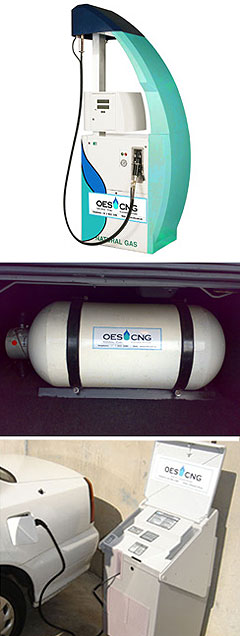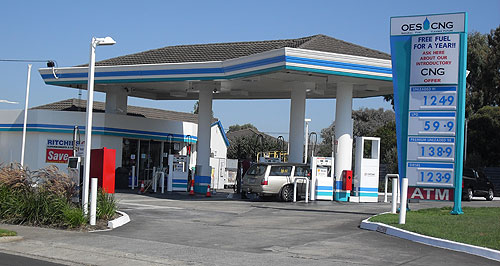News - General NewsOES takes lead on public CNG retail outletsFuel for thought: OES CNG’s retail outlet in south-east Melbourne is billed as the first ‘full public access’ CNG service station in Australia. Melbourne firm opens first of at least six public CNG fuel outlets in Australia15 Apr 2010 By TERRY MARTIN THE first service station in Australia offering full public access to compressed natural gas (CNG) has opened in Melbourne, with the company behind it planning to open another five retail outlets in Victoria over the next 12 months. Owned and operated by Melbourne-based OES CNG, which is also a developer of aftermarket CNG systems, the service station in the south-east suburb of Aspendale Gardens is designed to cater for a growing number of passenger cars and light commercial vehicles that are designed, or have been converted, to run on the alternative fuel. GoAuto understands there are three other public refuelling stations in Australia – two in NSW (Sydney and Goulburn) and one in Canberra – that require a specific account with ACT-based energy utility ActewAGL, which according to OES leaves its Melbourne outlet as Australia’s first unrestricted CNG outlet. Its emergence is a significant step in the drive towards a national refuelling infrastructure which will be required before any widespread introduction of CNG-powered new cars and LCVs – and an increased uptake of aftermarket conversions – can be expected in Australia. As GoAuto has reported, CNG is well established overseas but is largely the domain of heavy commercial vehicles in Australia, with refuelling generally undertaken at private depots. That has not deterred Mercedes-Benz in recently releasing a CNG-powered Sprinter van, which joins other light trucks from companies such as Isuzu.  Left: OES CNG bowser, CNG tank, CNG small fleet refuelling station. Left: OES CNG bowser, CNG tank, CNG small fleet refuelling station. Despite throwing its weight behind a national E85 ethanol network and developing compatible models, Holden has also specifically included CNG among the alternative fuel technologies to be considered for its Australian-built Cruze hatchback (and locally built sedan) due for release in 2011, which would be a first for a passenger car on the Australian market. OES CNG manager Kevin Black has told GoAuto that the company plans to open four more outlets in metropolitan Melbourne over the next 12 months, with another in northern Victoria. In the following year, it will look at opening more outlets in other Victorian regional areas, such as Bairnsdale, Ballarat and Bendigo. “It will depend a little bit on acceptance and rollout as to where we actually get it (service stations in place) – we’re getting a lot of enquiries at the moment about when we can get some facilities into places like Sydney or Brisbane,” Mr Black said. CNG is a cheap, clean and relatively safe fuel and has a proven track record overseas. Natural gas is also in abundance in Australia, and unlike LPG (liquefied petroleum gas) – which is a mixture of propane and butane and is generally a by-product of the petrol refining process – CNG’s price at the bowser is not linked to world oil prices. Mr Black said CNG also has the same energy content as diesel, and slightly more than petrol, meaning its consumption and potential driving range are comparable. Despite this, OES is selling CNG at 75 cents per kilogram, which it says is equivalent to paying 55 cents a litre for diesel, 50c a litre for petrol or 33c a litre for LPG. Mr Black said OES was making the investment in CNG despite the lack of CNG-powered vehicles on sale, and the corresponding lack of public awareness, suggesting that over time it should become as significant as LPG. “One of the things that we in the CNG industry are trying to ensure is that there is a range of fuel alternatives because the one thing we don’t want to be doing going into the next 20 or 30 years is to be totally dependent on oil, and we see this as being part of the answer for energy security in Australia,” he said. “For Australia, I would hope that we can get a similar market penetration to what LPG has at the moment by, say, 2020 – somewhere around eight to 10 per cent of the fuel market by then. “I can’t honestly say it’s going to be greater than that. It will all depend on a whole range of issues, including things like government fuel policies, excise policies, climate change policies, that sort of thing, and whether the government sees fit to provide concessions of some sort to indigenous or clean fuels. “We expect that will be an imperative as time goes on – there’s no guarantee that it will, but we’re betting our investment on it anyway.” According to OES, CNG is the fastest-growing sector of the automotive industry worldwide with an annual growth rate of more than 30 per cent. While Australia has an estimated four public CNG refuelling stations, Argentina has 1400, Brazil 1200, the US 1300, Pakistan 1000, Germany 650 and Italy 500, to name just a few of the major markets. ActewAGL manager of gas networks Mackleay Connelly told GoAuto in February that the rollout of publicly accessible CNG filling stations would be a challenge, and that the existing domestic CNG network – that is, delivering gas to homes in many Australian cities – could be employed, with vehicle owners using a home refuelling unit. “If you look at the way that the oil companies distribute their fuel, it’s road transport. Look at the way the natural gas industry distributes its fuel, (it is by) pipelines – very low cost, very safe, very efficient and it exists today,” he said. Mercedes Vans Australia general manager Campbell York told GoAuto that the company had decided to take a leadership role with the introduction of its CNG-powered Sprinter. “You can adopt the policy of being a leader or a follower and we choose to be a leader,” he said. “(And) we have had significant enquiries from people interested in us bringing in alternative fuelled vehicles.” In other alternative fuel news, Mazda Australia has announced that it would use E85 ethanol fuel to power its turbocharged rotary RX-8 SP rally car in the forthcoming Targa Tasmania. Following the lead of V8 Supercars, which now requires E85 to be used, Targa Tasmania’s event regulations now encourage competitors to consider alternative fuels. Event organisers have also set a target of achieving zero net emissions by next year’s 20th anniversary event. “Covering long distances at competition speed can really put a lot of pressure on an engine, particularly one that is turbocharged,” said Mazda Motorsport chief Allan Horsley. “In short, engine cooling in an endurance rally like Targa can make or break your campaign – so it’s absolutely vital to get it right. “It was a long and fiddly process making the turbocharged rotary compatible with E85 but because all petrol-powered Mazda passenger vehicles can run on E10 blend fuel, it made the process a lot easier.”  Read more |
Click to shareGeneral News articlesResearch General News Motor industry news |
















Facebook Twitter Instagram